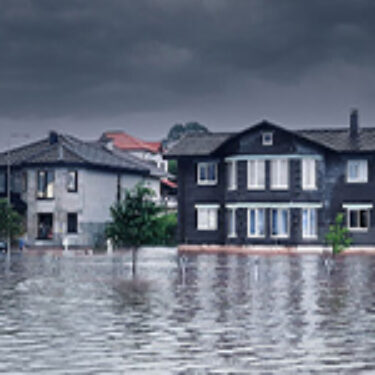Communities from Florida to the Northeast are recovering from the effects of Hurricane Debby, which brought flooding rain and multiple tornadoes from Florida to the Northeast. Earlier this year, forecasts predicted an above average, or even record-breaking number of storms in 2024, due in part to unusually high ocean temperatures and the effects of La Niña, NBC News reported.
For homeowners and commercial property owners across the U.S., the trends mean a heightened risk of costly flood losses. The rising costs highlight the need for Flood Insurance, which more homeowners are now required to obtain and is becoming increasingly expensive in certain areas.
Featured Solutions
Even in areas considered to be at lower risk for flood, inland flooding is a rising threat, said Jacob Martin, Manager, Flood, Burns & Wilcox, Charlotte, North Carolina. Homeowners in these places may be less likely to purchase Flood Insurance, especially if it is not required by their mortgage lender.
“Individuals think hurricanes only really cause a lot of issues at the coast, but what happens after that is these usually go inland and cause a lot of flooding,” Martin said. “It is not unusual to see a lot of claims come out of Ohio, West Virginia, or Kentucky — they get all the rain that is the secondary part of the event.”
More homeowners will be required to buy Flood Insurance
In some areas, more homeowners are now required to purchase Flood Insurance based on updated flood maps by the Federal Emergency Management Agency (FEMA).
In South Florida, Broward County added 88,000 properties to its flood zones based on the updated maps, CBS News reported. Effective July 31, these homeowners are required to purchase Flood Insurance if they have a federally backed mortgage.

After a flood event, a lot of businesses — especially if they are not insured — have to close their doors.
“Despite the shock to homeowners, the changes make sense,” Turner said. “That particular area is very susceptible to flooding — even sunny-day flooding. We have already had several events over the last year, and I am glad that awareness is being raised. There is a lot of exposure in Southern Florida, both from a rainfall perspective and obviously from tropical events, as well.”
That risk “has always been there” for these homeowners. “It takes a long time for those flood maps to update,” Turner said. “What you are seeing now is really a look into the past of what the perceived exposure was.”
Although some of the flooding in Southern Florida was considered rare — like a “1-in-1,000-year” downpour that caused major damage in Fort Lauderdale in April of 2023 — it is still possible, Martin noted.
“There may be a low percentage chance that it could happen annually, but those types of events can happen. Homeowners and business owners need to be prepared for that,” Martin said. “Under their typical Homeowners Insurance or Commercial Property Insurance, flood would not be covered. They have to go out and seek Flood Insurance separately.”

There may be a low percentage chance that it could happen annually, but those types of events can happen. Homeowners and business owners need to be prepared for that. Under their typical Homeowners Insurance or Commercial Property Insurance, flood would not be covered.
Flood Insurance can be purchased through FEMA’s National Flood Insurance Program (NFIP), which limits coverage to $250,000 for a building and $100,000 for its contents, or it can be purchased through the private Flood Insurance market, which can offer higher limits and more expansive coverage.
Higher-value homes in coastal areas will usually need higher limits than the NFIP can offer, making a secondary policy necessary, Martin said. “A lot of times, we can find a market for them. If some type of large, catastrophic event happens, they want to make sure they are covered.”
Finding coverage for basement contents, loss of use
According to data from the U.S. Congressional Joint Economic Committee, floods in the U.S. cost between $179.8 billion and $496 billion in total damages per year. When properties experience a flood loss, the average Flood Insurance claim payment over the past five years has been about $69,000, according to FEMA.
Claim averages have doubled over the past five years, Turner said, and even property owners who do carry Flood Insurance may not have adequate coverage. “It costs a lot more to rebuild a property in the current day and the limits available [with the NFIP] are not really enough to sustain a flood loss,” he said.
According to Martin, all private Flood Insurance policies must be “at least as broad as the NFIP,” and most policies provide benefits beyond what the federal program can offer. In addition to higher limits, coverage options may include personal property in the basement, landscaping, pools, and loss of use, including temporary housing and additional living expenses while a home is being repaired after a loss. “There is a lot of coverage available in the private market that is not available in the NFIP, but it is always at least as broad,” Martin explained.
Inflation and rising property values are also important to consider when purchasing Flood Insurance, particularly as reconstruction costs go up. “I would really encourage individuals to look at the valuation and make sure it is adequate. If you are concerned about the amount of coverage that you have, definitely shop and look for an excess policy,” Martin said.
Options like Burns & Wilcox’s FloodPlus program offer even broader policy language than the NFIP and standard market, Turner said. Backed by one of the largest Lloyd’s syndicates, FloodPlus leverages a unique API that pairs advanced risk modeling and claims data with the broadest Primary Flood coverage available in the market. It offers coverage for leaseholder’s improvements and betterments, increased coverage for enclosures and basements, loss of use coverage including additional living expenses, rental income and commercial business income. All flood zones are eligible, and no elevation certificate is required.

After a flood event, a lot of businesses — especially if they are not insured — have to close their doors.
“FloodPlus has extended language that covers enclosures, whether they are in a flood zone or not,” Turner said. “It offers the most extensive coverage options that exist in the market at this point.”
Commercial property owners also typically look to the private Flood Insurance market for expanded offerings and higher limits. The value of these properties tends to be “exponentially higher,” Turner said, adding that loss of business income and other indirect losses can be covered. “After a flood event, a lot of businesses — especially if they are not insured — have to close their doors. If a business owner has not explored private Flood Insurance, I would really recommend they reach out and evaluate what options are available,” he said.
Preparing for a ‘hyperintense’ storm season
Following Hurricane Beryl’s landfall in Texas, which led to at least seven deaths, many residents faced severe flooding in their homes, Houston Public Media reported July 10. The storm’s impacts were also felt in Chicago, Illinois, where heavy rainfall left many homes flooded, ABC 7 Chicago reported. The storm was part of what Turner described as a “hyperintense, active storm season this year.”
As climate change increases the frequency and severity of weather events, “we are going to see [floods] continue to increase as we move further in time,” he said.
Premium increases can be expected, as well. In Maine, homeowners are estimated to see Homeowners Insurance premiums increase 19% next year, with coastal homeowners at risk for flood expected to see more significant rate hikes, WGME reported on June 6. “If homeowners are seeing large increases in their pricing, I would encourage them to shop their coverage,” Martin suggested.

You can have a flooding event pretty much everywhere in the country. The reality is these events are happening all the time and it only takes one to impact your life in a very significant way.
Despite higher rates in some cases, today’s market for Flood Insurance has more options than ever before, Turner said. “There are a lot of coverages available, and it can vary greatly. It is worth it to shop coverage. Do not rely on the NFIP being the only source of Flood Insurance.”
Property owners should also remember that, whether a property is in a FEMA flood zone or not, there will always be a risk of flooding. “FEMA never says anywhere is ‘safe,’” Martin said of flood maps. “You can have a flooding event pretty much everywhere in the country. The reality is these events are happening all the time and it only takes one to impact your life in a very significant way.”









